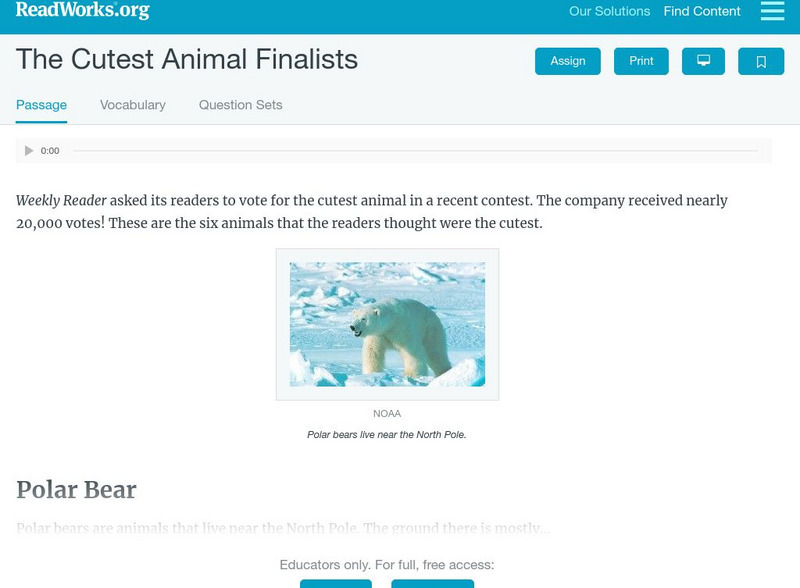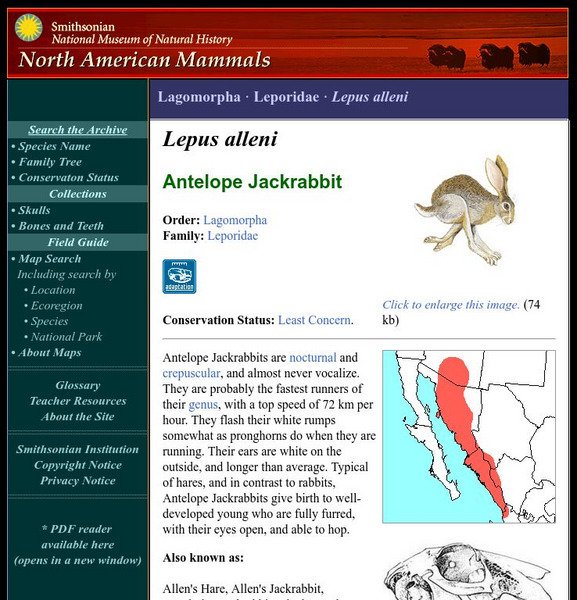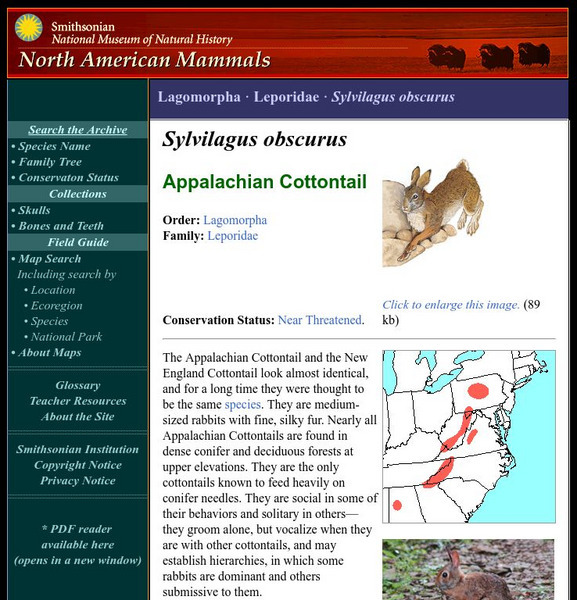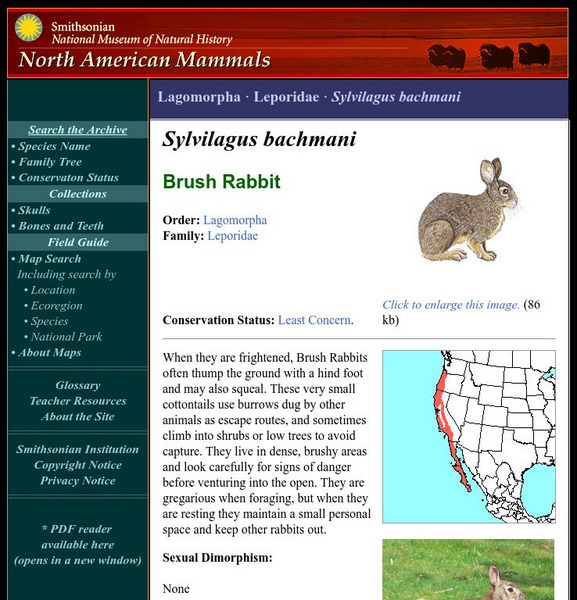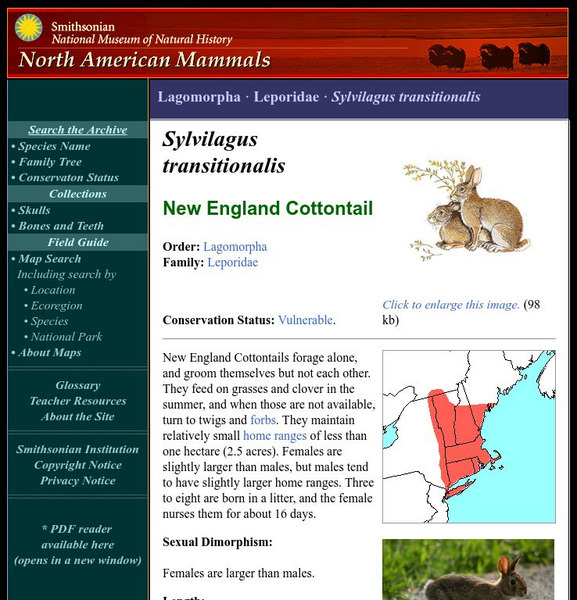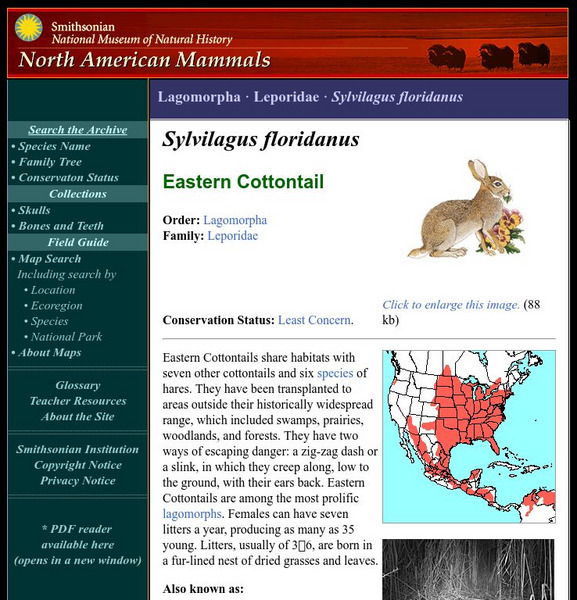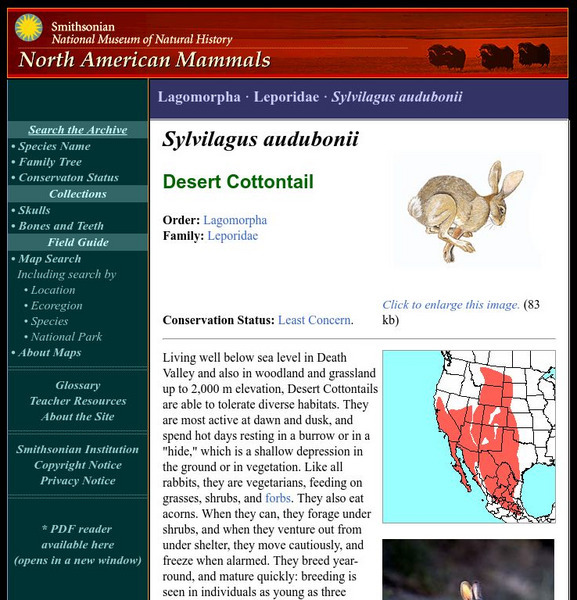Read Works
Read Works: The Cutest Animal Finalists
[Free Registration/Login Required] This passage shares the information about animals that students have voted as being "the cutest" in a Weekly Reader contest. This passage is a stand-alone curricular piece that reinforces essential...
Center for Innovation in Engineering and Science Education, Stevens Institute of Technology
Ciese: How Does Your Garden Grow?
Based on the book Muncha! Muncha! Muncha! by Candace Fleming. Students must use the engineering design process to plan and build a barrier that will keep hungry bunnies out of a garden.
Enchanted Learning
Enchanted Learning: Rabbits
A complete site of rabbit information. The anatomy, diet, and habitat is covered. In addition, links are provided to a rabbit quiz with answers and a rabbit themed unit.
PBS
Nh Pbs: Nature Works: Eastern Cottontail
Explore the world of the Eastern Cottontail. Find out about this mammal's habitat, characteristics, diet, life cycle, range and behavior when you visit this educational resource.
PBS
Nh Pbs: Nature Works: Black Tailed Jackrabbit
Explore the world of the Black-tailed Jackrabbit when you visit this educational site. This site features information on the habitat, characteristics, range, diet and more of this fascinating placental.
Concord Consortium
Concord Consortium: Evolution: Variations and Adaptations
Students discover that variation in plants allows some varieties to survive in near-drought conditions. Next, students learn that different types of rabbits prefer to eat different varieties of plants. Students make the connection...
Encyclopedia of Life
Encyclopedia of Life: European Rabbit
The Encyclopedia of Life presents this in-depth overview of European Rabbits (Oryctolagus cuniculus), including their habitats, size, conservation status, and much more. Images of this species and maps of its global distribution can also...
Other
Rabbit breeds.org: All Rabbit Breeds
A collection of the rabbit breeds in alphabetic order. A picture is given for each breed.
Other
House Rabbit Society
This resource provides extensive information on how to care for your pet rabbit in the home. Start with "House Rabbits 101" to get a handle on the basics, and explore the website for guides on diet, housing, litter training,...
Other
House Rabbit Network: Classroom Bunnies Why Not?
Although this site lists a number of reasons why rabbits in the classroom are not a good idea, there are many informative facts on this site that will educate all interested parties on the care and needs of rabbits.
ClassFlow
Class Flow: Rabbits
[Free Registration/Login Required] This flipchart contains information and pictures of rabbits in the wild.
Smithsonian Institution
National Museum of Natural History: American Mammals: Antelope Jackrabbit
Antelope Jackrabbits are nocturnal and crepuscular, and almost never vocalize. They are probably the fastest runners of their genus, with a top speed of 72 km per hour. Learn more about the Lepus alleni, more commonly known as an...
Smithsonian Institution
National Museum of Natural History: American Mammals: Black Tailed Jackrabbit
Black-tailed Jackrabbits are tremendous leapers, able to jump more than 6 m horizontally. They live in some of the hottest and driest regions of the continent, can survive on poor-quality foods, and get most or all of the water they need...
Smithsonian Institution
National Museum of Natural History: American Mammals: Appalachian Cottontail
The Appalachian Cottontail and the New England Cottontail look almost identical, and for a long time they were thought to be the same species. They are medium-sized rabbits with fine, silky fur. Learn more about the Sylvilagus obscurus,...
Smithsonian Institution
National Museum of Natural History: American Mammals: Brush Rabbit
When they are frightened, Brush Rabbits often thump the ground with a hind foot and may also squeal. These very small cottontails use burrows dug by other animals as escape routes, and sometimes climb into shrubs or low trees to avoid...
Smithsonian Institution
National Museum of Natural History: American Mammals: White Tailed Jackrabbit
White-tailed Jackrabbits live at a remarkably broad range of elevations, from 40 m to 4,300 m, and where they are in competition with Black-tailed Jackrabbits, they tend to move toward higher elevations. They are slightly larger than...
Smithsonian Institution
National Museum of Natural History: American Mammals: White Sided Jackrabbit
The White-sided Jackrabbit strongly prefers level ground to hills, and does not require shrubs for cover, but uses clumps or dense stands of grass instead. Grass also makes up more than 99 percent of its diet. Learn more about the Lepus...
Smithsonian Institution
National Museum of Natural History: American Mammals: Pygmy Rabbit
Pygmy Rabbits dig extensive burrow systems, which are also used by other animals. Loss of habitat is a direct threat to this species, which depends on big sagebrush, particularly mature stands of it. Learn more about the Brachylagus...
Smithsonian Institution
National Museum of Natural History: American Mammals: Swamp Rabbit
The Swamp Rabbit is the largest North American cottontail, but has relatively short ears in proportion to its size. It forages for grasses, sedges, some tree seedlings, and other plants in marshy lowlands of the south-central United...
Smithsonian Institution
National Museum of Natural History: American Mammals: New England Cottontail
New England Cottontails forage alone, and groom themselves but not each other. They feed on grasses and clover in the summer, and when those are not available, turn to twigs and forbs. Learn more about the Sylvilagus transitionalis, more...
Smithsonian Institution
National Museum of Natural History: American Mammals: Marsh Rabbit
Marsh Rabbits live only in marshy areas, and like Swamp Rabbits, are good swimmers. They are often found in habitats with pools of brackish water and plants such as cattails, water hyacinth, rush, centella, and marsh pennywort. Learn...
Smithsonian Institution
National Museum of Natural History: American Mammals: Mountain Cottontail
At dawn and dusk in the mountainous regions of the western United States, the Mountain Cottontail forages for sagebrush, western juniper, and grasses, almost always close to cover. As befits a rabbit that lives where it gets very cold,...
Smithsonian Institution
National Museum of Natural History: American Mammals: Eastern Cottontail
Eastern Cottontails share habitats with seven other cottontails and six species of hares. They have been transplanted to areas outside their historically widespread range, which included swamps, prairies, woodlands, and forests. Learn...
Smithsonian Institution
National Museum of Natural History: American Mammals: Desert Cottontail
Living well below sea level in Death Valley and also in woodland and grassland up to 2,000 m elevation, Desert Cottontails are able to tolerate diverse habitats. They are most active at dawn and dusk and spend hot days resting in a...


